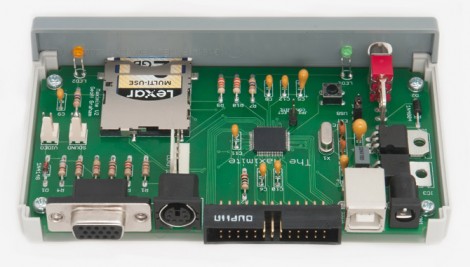
Here’s a photo of the circuit board for the Maximite, a BASIC interpreter that [Geoff] built. The design idea was sparked when he was exploring the possibilities of the PIC32 family of chips. [Geoff] wanted to write about the hardware for a magazine article but needed an actual product to really show it off.
The design can utilize one of two microprocessors, a PIC 32MX795F512H or 32MX695F512H. The 32-bit chip has more than enough power to emulate BASIC, and even allows for floating point calculations. It’s VGA compatible and has a jack for a standard PS/2 keyboard, which makes it a standalone device. You can store programs on an SD card, or it can be interfaced with a computer via the USB-B port that you see next to the power jack. The microprocessor is a surface mount chip, but the rest of the components are through-hole, making this an easy kit to assemble. But if you’re not afraid to etch your own 2-layered PCBs there is board artwork available in [Geoff’s] download package.
[Thanks Bill]















So it’s a modern 80’s era computer. I like.
Nice, but pretty much all 80’s home computers interpreted Basic and had floating point ops and they managed with weeny 8-bit processors.
I think the clever bit is that this does VGA and composite video generation in software while interpreting Basic, and that the PIC has 128k of RAM built in which is a big deal for a microcontroller.
Would prefer to just plug my C64 in
I like it. Just last week I was ‘wishing’ for a C-64 type box (not the ‘new C-64’) to use to teach some basic level stuff, without having to get into Classes, Objects, etc. This could meet my needs very nicely.
Astounding 80MHz embedded controller that will execute your BASIC progs from the SD card at powerup. It only consumes 140mA. It has 20 input/output pins (10 of which can be A/D).
Amazing, me want!
PS: Here’s the manual if anyone’s interested…
http://geoffg.net/Downloads/Maximite/Maximite%20User%20Manual%20V2.2.pdf
This looks like it’d be great to give to a smart nerdy kid who’s ready to learn the basics of programming and electronics, but not ready to learn about APIs and oscilloscopes and et cetera and so forth.
This feels like a better idea than the Raspberry PI little computer. It’s a shame that BASIC is such a dog of a language though :p
I very much like the project.
Hooray, I am a big fan of this sort of thing.
These days it’s a big hurdle to get close to the hardware; either you need to go through a complex computer and operating system, or you need a microcontroller and the associated software toolchain for it.
I would like to see more people making and using simple stand-alone computers. Maybe they could make a comeback.
My current project involves putting a beagleboard in a (large) laptop-like case with external hookups for SPI, I2C, and GPIO (which can be accessed through userspace programs). It also has a “tincan tools trainer board,” which is a breakout for the above that includes an AVR. Lots of cool possibilities there…
This is the current firmware version (2.4) and it’s user manual. http://geoffg.net/Downloads/Maximite/Maximite%20User%20Manual%20V2.4.pdf
Got on, love it. Graphics is in monocrome though!
Love it Geoff
Good to see the Maximite on Hackaday. most ersitile and easy project to assemble for a PIC32MX device.
Still working on the idea to use another PIC to act as a colour video controller on your Maximite.
i wonder how hard it wood be to convert into a bus pirate
just change the sd card for difrant protocalls
@Aaron: …never mind that said kid more or less certainly already has a phone (probably with TV-out built in) that can also run your choice of BASIC interpreter (and also has an SD card).
Just sayin’.
I like it. Reminds me a bit of an old Timex-Sinclair for some reason.
A shame it isn’t a bit cheaper, considering how little the parts cost. The price doesn’t seem to be putting people off much though, it’s sold out everywhere.
Hopefully this will continue to evolve past imitating Microsoft Basic, too. Although I have no problem with BASIC, I just can’t imagine ever using a dialect with line numbers again.
I would love to make/buy one of these and port eLua (http://www.eluaproject.net/) to it (although I’m sure it could still be fun with BASIC, but I like OOP).
Built one from the Altronics kit (www.altronics.com.au) supplied with 680k not 680R resistor in VGA output stage will only just work with an old VGA monitor but not with any LCD analogue or digital VGA tested using the VGA port, other negatives are the on off switch needs to be rewired to work with USB power (it only switched plugpack DC), fiddly with which SD cards work, and with windows Vista and windows 7 MS no longer supply hyperterm which you need to steal from an ol XP box. Lastly battery backup of programs in memory would be good instead of having to load and save to SD all the time
one positive thing about maximite, the basic interpreter is a lot easier to use and more intuitive than the BV513 alternative. Also not documented but the byvac com program seems to run OK with the maximite and also at a 200,000 baud rate not just the 9600 baud documented by silicon chip. Looking at both products the maximite wins in my view